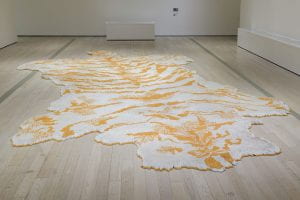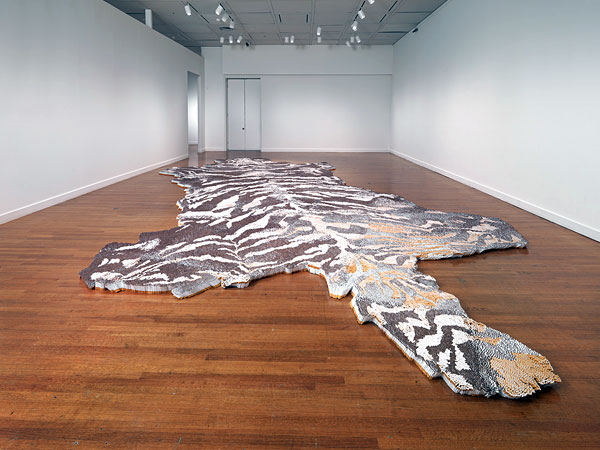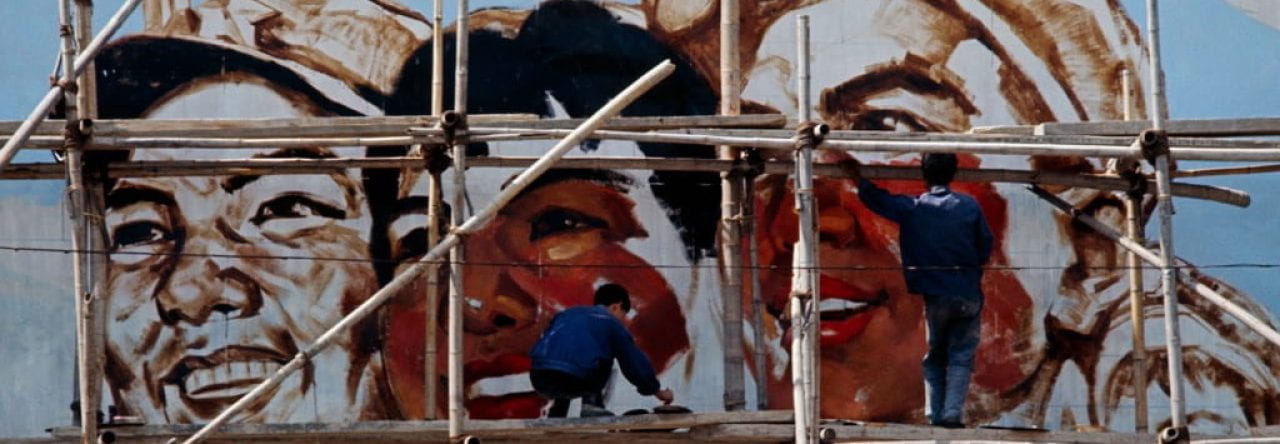In a line of works titled “Tobacco Project” Xu Bing symbolized humanity’s relationship with tobacco across art works including a book of tobacco slogans printed on tobacco leaves. This specific installation is a mock- tiger rug made of over half a million ‘1st Class’ brand cigarettes, carpet, and adhesive, and Xu Bing named it accordingly “1st Class”. 40 feet long and 15 feet wide, “1st Class’ is a larger than life tiger skin symbolizing “human prowess: it confirms our superiority by transforming one of nature’s fiercest predators into a lifeless skin beneath our feet.” (Ravenal, 2011) The oversized quality of the skin is no coincidence, as Xu Bing aims to invoke a slightly remorseful self-reflection. The size also doubles as a way to make one artwork into two: a massive collection of cigarettes and separately an oversized tiger rug, and the oversized tiger could additionally signify an especially dangerous or threatening animal. As a tiger rug is associated with “luxury, status, and domination” Xu Bing forces the viewer to think about the correlation between these traits and humanity’s relationship with smoking cigarettes. Ravenal writes “The beauty of the tiger-skin pattern, its allusions to the dangerous thrill of the hunt, and the uncanny allure of the massive display of cigarettes ironically glamorize the addictive pull and risks of smoking.” (Ravenal, 2011) The monochromaticity of the tiger is clearly not made to look realistic, but it is rather an artistic decision to switch the oranges and blacks of normal tiger skin to white and orange (with orange stripes over a white background, keeping the color scheme as that of the cigarettes). However, from other viewpoints some of the tiger skin looks like a darker brown color, and this is because from standing on the other side you can see down the end of the cigarette, creating a darker sort of stippled look. This may emulate two different views of or opinions on cigarettes; those who enjoy them for the taste and/or feeling, and those who are suffering from addiction or physical health problems manifested from smoking.




Athanasia Kytoudi
This analysis provides a deep dive into Xu Bing’s work, exploring its symbolism, material usage, and artistic decisions and it can serve as a strong example of how to unpack the layers of meaning in a piece of art. Xu Bing’s work serves as a critique of humanity’s relationship with tobacco, using the symbol of a tiger skin rug made from cigarettes to explore themes of luxury, status, domination, addiction, and health risks associated with smoking. For similar projects that focus on the use of unconventional materials in art, Xu Bing’s use of cigarettes as a medium offers an interesting case study. This text analysis could be helpful in understanding how artists can manipulate everyday items to create profound symbolic meaning. The text also discusses how the artwork changes based on the viewer’s perspective, with the color and perceived patterns of the ‘tiger skin’ altering, which is valuable for concepts of perception of art.